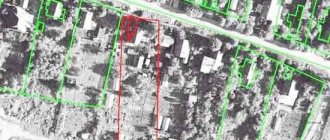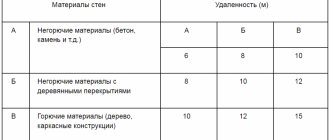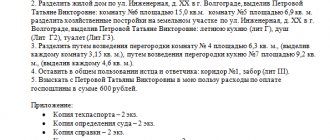16
There are a great many situations when the owners of a residential building and the land plot on which the building is erected want to make a real division of property.
Among the most popular:
- division of the house as jointly acquired property between spouses during or after divorce;
- division of an inheritance issued in equal or proportional shares to one or more heirs;
- allocation of a co-owner's share in case of common shared ownership (for example, if we are talking about a house “for 2 owners”).
In any of the listed cases, the parties to the dispute can either resolve the dispute peacefully by making a mutual decision on the division of property and concluding an agreement, or demand the division of property through the court. An example of a voluntary division is an agreement between heirs on the division of inherited property.
How is a plot divided when dividing a house into parts?
Division of a land plot, in particular the allocation of a share from it, while maintaining common shared ownership of residential real estate, cannot be possible due to the following reasons:
- clause 1 art. 1 of the Land Code of the Russian Federation, it is regulated that one of the principles of land legislation is the indivisibility of the fate of plots with buildings located on such real estate, with the exception of cases provided for by law;
- Art. 273 of the Civil Code of the Russian Federation stipulates the principle of unity of the land plot and the buildings erected on it;
- Art. 35 of the Land Code of the Russian Federation prohibits the alienation of a plot of land without premises located on it, if such property belongs to one owner.
Expert opinion
Stanislav Evseev
Lawyer. Experience 12 years. Specialization: civil, family, inheritance law.
When alienating a task located on a plot owned by several persons, the division is made in proportion to the shares belonging to such owners.
Taking into account the stated norms of legislation, before dividing a land plot, it is first necessary to allocate shares of residential premises in kind.
Thus, the division of land, due to the fact that it contains residential and non-residential real estate objects such as a house or other utility premises, becomes much more difficult.
In this case, the approach to dividing real estate is carried out according to completely different rules, including on the basis of the owner’s decision to divide the plot.
Features of shared ownership
Shared ownership is a type of common ownership. The documentation for the premises indicates the exact amount of property of each owner.
The ownership documents indicate the exact size of each share of the property
When separation does not occur:
- each owner uses all the premises of the house and the area of land adjacent to it;
- the owners independently agree on the use of common property;
- when it is not possible to separate a share in kind in an apartment, compensation can be applied; Utility payments are distributed in proportion to shares.
The features of shared ownership are determined by their individual procedure for use and sale.
How does it happen and why is it necessary to allocate a share in kind from the common property of a private house?
Options for dividing the house and plot
Thus, the most optimal option is to divide the housing between all owners into parts proportional to the shares of these persons. Moreover, each section of the building must have its own separate entrance.
In addition, the local area, as well as all adjacent buildings and non-residential structures, are subject to division. However, such a division may be practical provided that the number of owners does not exceed two people. Otherwise, it will be possible to comply with these requirements only if the property has a sufficiently large area.
See the similar material “Dividing a land plot into two”.
The examples given are not the only indicator of the complexity of dividing a plot when dividing a residential building. In this regard, the courts, taking into account the opinions of all owners, may decide to transfer residential real estate, land plots and other non-residential premises into shared ownership, with further determination of the procedure for the use and ownership of such real estate.
In addition, there are cases when the division of the plot occurs together with the division of real estate under construction.
To resolve such a controversial situation, the court takes into account the following:
- the degree of completion of construction work, as well as the stage at which they are;
- availability of technical expertise;
- the likelihood of continuing construction after the real division of property between the owners.
How to divide a plot of land and a residential building
In order to make a real division of the house and land, you can go in two ways, namely:
- enter into a voluntary agreement;
- resolve this issue in court.
Of course, the voluntary method of division is simpler and cheaper for the parties, and also does not require lengthy consideration, unlike a lawsuit. Alas, it is sometimes difficult to obtain consent and cooperation from the second owner for the division of a house and land, so such disputes often lead straight to court.
By agreement
The most objectively convenient way to carry out this division is to conclude a voluntary agreement between the owners on the division of real estate and the increase in shared ownership.
In order for this process to end with state registration, the document must stipulate all the essential conditions for the division, as well as attach to it a project for surveying the plots being created and a conclusion on the possibility of dividing housing.
Notarization of such an agreement is not required; the document is submitted to the Rosreestr unit at the location of the real estate, after which the body registers the transfer of rights.
The agreement must indicate all relevant circumstances and information, including:
- Date and place of conclusion of the agreement.
- Full information about the parties: full name, passport details, registration and actual residence addresses.
- Details of registration of rights to shared property.
- Description of the property to be divided.
- A description of the division order, to whom and what is transferred, a link to technical expertise, if any.
- Compensation payments, if any, are provided (for example, for a larger share of land going to the second owner).
- The procedure for registering rights, description of expenses and their distribution.
- Technical information on the house and plot.
- Personal signatures of the parties with transcripts.
The agreement, along with the necessary documents, is submitted to the Rosreestr authorities (or through the MFC) for registration.
Documentation
To register new objects allocated from common shared ownership, you will need to submit to Rosreestr:
- an application for state registration of rights to the allocated objects from each party to the agreement;
- documents confirming the rights to the plot and house;
- agreement;
- technical documents: cadastral passport, technical passport, etc.
- expert opinion, if required;
- copies of the passport (the original is presented when submitting documents);
- receipt of payment of duty.
If documents are submitted by a representative, you need a power of attorney certified by a notary with specified rights to submit and receive documents, as well as to sign an agreement.
When applying for registration, each applicant will have to pay a fee of 2,000 rubles.
Features of the agreement section
Very often, the parties, even without disagreements, cannot divide a residential building and the land plot underneath it for purely technical reasons.
Among them:
- errors in the documents that provide the basis for registering rights and issuing title documents for the house and land, which cannot be corrected;
- impossibility of explicitly determining shares from documents;
- errors in the area, configuration of the house.
Example. In the late 80s and early 90s, standard houses with two apartments were built in many cities across the country, with completely separate exits, communications, and adjacent territories. Basically, such houses were provided to employees and workers of state enterprises, having been transferred to them under privatization agreements. In almost all cases, such houses were registered as common shared ownership with ½ share for each owner.
At present, it is impossible to make a voluntary division of such property, since according to all the documents, separate apartments are not reflected, only the total area of the house is indicated. As a result, the owners of such houses are forced to conduct an examination confirming the possibility of a real division or, at a minimum, with the participation of the BTI, draw up new technical documents for the property.
Sample agreement for voluntary division of a house
When drawing up a document, it is better to use the services of a lawyer or at least get a free consultation from a specialist in this field. Ask questions right now or use the sample below to compose your own.
Sample agreement for voluntary division of land
Remember that the slightest mistake made when drawing up the agreement will result in a refusal of state registration of new borders. You can use the sample below, but it is advisable to ensure that the document you select is correct for your situation.
Consult our lawyer free of charge on the correct drafting of an agreement for the division of a plot of land for a residential building.
Leave a comment on the document
Do you think the document is incorrect? Leave a comment and we will correct the shortcomings. Without a comment, the rating will not be taken into account!
Thank you, your rating has been taken into account. The quality of documents will increase from your activity.
| Here you can leave a comment on the document “Agreement on the real division of a residential building”, as well as ask questions associated with it. If you would like to leave a comment with a rating , then you need to rate the document at the top of the page Reply for |
Through the court
Practice shows that the owners of the said real estate are not always able to come to a compromise and resolve the issue peacefully.
Also, stalemate situations and mistakes that preclude voluntary division of the house and land often push people to court.
In this case, the only option for dividing the land and house is a judicial procedure.
Procedure
So where to start and how to complete the forced division of real estate?
This process must go through the following steps:
- the person initiating the trial determines the size of the shares of the disputed property for each of the co-owners, establishing the possibility of carrying out a division from a technical point of view;
- a statement of claim is drawn up, the subject of which is the allocation in kind of shares of a residential building and a land plot, after which the document with all supporting documents is sent to the court;
- If the claim complies with all procedural norms, the court accepts it for proceedings, after which the process of considering the case on the merits of the stated claims begins.
- At the meeting, a technical examination may be appointed, which will determine whether a real division of the house and plot is possible.
- Based on the results of consideration of the claim, the court makes a decision to allocate shares in the disputed property to each owner or establishes the procedure for its use. In the first case, in order to finally acquire property rights to the distributed shares, the owners need to register them with the Rosreestr authorities.
Statement of claim for division of house and plot
The general requirements for a claim are reflected in Art. 131-132 Code of Civil Procedure of the Russian Federation.
A statement of claim for the division of a land plot and the premises located on it is drawn up according to the following template:
- name and location of the judicial authority;
- personal data of all parties to the process: full name, registration address and actual place of residence;
- the price of the statement of claim – the value of the property if there is a dispute;
- the descriptive part of the claim, which sets out in detail all the details of the property relations of the owners of the disputed property, the procedure for its use and the shares of each owner;
- the reasons for which it is necessary to carry out the division forcibly are indicated, and all methods used for pre-trial settlement of disputed relations are also reflected;
- the motivation part contains a list of options proposed by the plaintiff regarding the division of the house and land. The specified block must contain a legislative substantiation of the applicant’s position;
- list of additional materials;
- signature and date of document preparation.
It is better to entrust the preparation of a statement of claim to professional lawyers from the field of housing and land law. If you are determined to prepare the documents yourself, then take advantage of the free legal advice of our specialists and ask them all the questions that concern you.
Sample claim for division of house and land in kind 2021
The slightest error in the statement of claim or omission of important content requirements prescribed in Art. 131 of the Code of Civil Procedure of the Russian Federation will lead to the judge leaving the document without movement or even to returning it. And this is wasted time that could have been spent preparing for the trial.
You can use the sample below to file a claim yourself, but it is better to enlist the help of an experienced lawyer. Consultation with our specialists is completely free.
Documentation
In addition, the following documents confirming the plaintiff’s position are attached to the claim:
- copies of passports of participants in the process;
- sample claims for each side of the case under consideration;
- documents confirming property rights to the disputed property;
- cadastral passport of the land plot, technical passport of the BTI of the residential premises and other technical documentation;
- if available, expert opinions on the possibility of dividing real estate;
- confirmation of payment of state duty.
State duty
Tax and civil procedure legislation provides for the need to pay a state fee in the event of a statement of claim being submitted to the court. Taking into account the fact that this category of claims is of a property nature, the amount of tax is calculated based on the price of the statement of claim.
The rules for determining the duty are regulated by Art. 333.19 of the Tax Code of the Russian Federation according to a formula consisting of such variables as the cost of the claim, a fixed rate and the corresponding percentage.
You can calculate the fee yourself using the data from the table below.
| Cost of claim | Calculation formula |
| Up to 20 thousand rubles inclusive | 4% of the claim amount, but not less than 400 rubles. |
| From 20,001 to 100 thousand rubles | 800 rub. + 3% of the claim amount exceeding 20 thousand rubles |
| From 100,001 rub. up to 200 thousand rubles | 3200 rub. + 2% of the claim amount exceeding 100 thousand rubles |
| From 200,001 to 1 million rubles | 5200 rub. + 1% of the claim amount over 200 thousand rubles |
| More than 1 million rubles | 13200 rub. + 0.5% of the amount over 1 million rubles, but not more than 60 thousand in total |
Where to submit
If the estimated value of all property subject to division does not exceed the amount of fifty thousand rubles, then the claim is considered in the magistrate's court. If the total cost is more than the specified amount, the claim is filed with the district court at the location of the land plot. This procedure is provided for in Art. 23 Code of Civil Procedure of the Russian Federation.
It is logical that there are no houses and land plots worth less than 50 thousand rubles left even in remote provinces, therefore in 99% of cases all claims for division must be filed with the district courts at the location of the real estate to be divided.
Procedure and process of judicial division
The court session begins with hearing the parties to the case. Find out their arguments and objections.
As part of the judicial process, forensic construction and land management examinations are mandatory if the possibility of a real division is not obvious, and the house itself does not have separate exits, communications, or associated territories.
The top priority is to establish the possibility of an ideal allocation of part of the real estate; if such actions cannot be carried out, then the division takes place based on the established procedure for use.
Experts offer various options related to establishing the boundaries of newly created land plots or rooms of a residential building, which become the property of each of the parties to the dispute.
If the examination has shown the need for reconstruction or redevelopment of the premises, the court determines in its decision the nature and type of work on the reconstruction of the disputed property that the owners will need to carry out.
The allocation of a share in a residential premises represents the transfer into the possession of one of the parties to the process of an isolated area of the house, which has a separate entrance. Also, the division of residential real estate can occur if it is possible to isolate such housing through redevelopment.
In addition, the degree of legality of the decision made is determined by compliance in such a document with the requirements of various norms.
Among which:
- construction;
- fire protection;
- sanitary and hygienic, etc.
Thus, experts should take into account the possibility of arranging a separate bathroom and kitchen, and supplying utilities. Only in this case can an expert opinion serve as a sufficient attribute for making a well-founded court decision.
In the process of conducting a land management examination of the disputed plot, the original land plot is surveyed. Also, the compliance of the minimum and maximum size of newly formed real estate objects, the unchanged intended use and other rules established by current legislation is checked. The division of a land plot without carrying out such actions regarding the buildings located on it is not allowed.
If the possibility of division is confirmed, the court makes a decision with reference to the options proposed by experts.
Why might you need to allocate a share in kind in a private house?
Allocation of shares is usually practiced if a private house is jointly owned
The presence of disagreements between owners is one of the main reasons for the emergence of situations related to the allocation of a share in kind of joint property.
As for the person who wishes to carry out this process, the existence of common property will be terminated for him. But individual ownership will be issued. In practice, this usually applies specifically to the home.
Several situations may arise in life that force you to resort to allocating a share in kind:
- This is often due to the need to sell or otherwise dispose of one’s part. For example, donating or adding additional space.
- This procedure will help in the future to avoid opposition from other owners. Without the consent of the owners of common property, it will not always be possible to donate, mortgage, or simply expand the square footage of the premises.
- There are situations when this procedure is due to the usual desire to register your individual property.
- This will help to move away from a number of restrictions associated with joint ownership. In this way, a person can protect himself in the future.
- Moreover, it is a good investment. When money comes in, you can build on it, thereby increasing the area. This will increase the value of the property, which, if the part is allocated, will not have to be shared with other owners.










